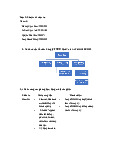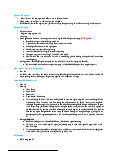







Preview text:
IM Organisation: - Goals, people and structure -
Ex: charity, funds, government, company, student association, clubs, business.. Managers: -
People who are responsible for gaining the org’s goals through directing the efforts of
people within the organisation. 4 types managers: -
Top managers: make decisions about the direction of the organisation. (CEO) -
Middle managers: manage others managers (CFO, COO) -
First-line managers: direct nonmanagerial employees. (team leaders,...) -
Team leaders: manage activities of a work team
=> only 3 top managers Management: -
Process of getting things done efficiently (maximise productivity) and effectively
(achieve high goals of org) with and through people
Functions are more preferable than roles
Every manager has the same 4 functions but divide
External environment: factors, forces, situations and events outside the company that affect it's performance.
Effectiveness is said to be "doing the right things" because effectiveness is
concerned with obtaining results and reaching goals.
Doing things "in the right way" results in efficiency rather than effectiveness. Note
that an enterprise can be effective—i.e., it can attain goals—without being efficient in
such areas as keeping costs and resources down. Doing things intelligently is clearly
part of an effective effort without being critical to it. The same can be said of doing
things when necessary—it is not a critical part of an effective effort Decision-making
Step 7: Decision Implementation
- putting a decision into action.
Planning = goals + plans
Types of decisions and decision-making conditions that managers face: Types of problems -
Structured: a straightforward, familiar, and easily defined problem -
Unstructured: a problem that is new or unusual for which information is ambiguous or incomplete. -
Programmed: repetitive decisions that can be handled using a routine approach. -
Nonprogrammed: a unique and nonrecurring decision that requires a custom-made decision.



